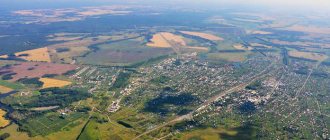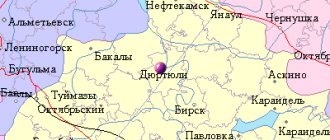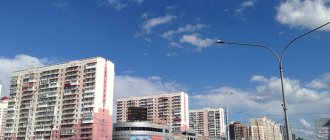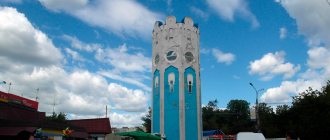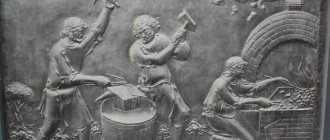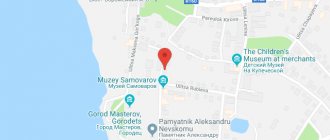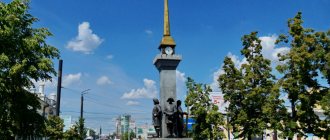Mayakovsky Square is one of the main symbols of Novokuznetsk. The monument to the poet is a tribute to his prophecy of the heavenly future of our city, which he cast with the steel of his immortal poems.
Why is Mayakovsky dear to us?
It just so happens that the “great”, only barely coming into contact with the history of our city, leave a noticeable mark on it. For their own creative biographies, these touches do not pass without leaving a trace. This was the case with Dostoevsky, who barely stayed in the city for a few weeks. Mayakovsky was not in the city at all. But he was sincerely amazed by the enthusiasm, courage and feat of the Kuznetskstroevites, dedicated several lines to the city and wished a bright, heavenly future.
Mayakovsky’s ode-poem was called “Khrenov’s Story about Kuznetskstroy and the People of Kuznetsk” (however, for a long time in the Soviet Union the surname “Khrenov” was removed from the title, and you will soon understand why). It begins with the epigraph-prophecy “From a Conversation”: “1,000,000 wagons of construction materials will be delivered to this place in the five-year period. There will be a metallurgy giant, a coal giant and a city of hundreds of thousands of people.” And the most famous lines of this work:
“I know there will be a city,
I know that the garden will bloom,
when such people
in a Soviet country!”
About creation
It’s not for nothing that the ode to Novokuznetsk is called “The Story,” and the information in the epigraph is marked “from the conversation.” Mayakovsky actually learned about the grandiose construction of the Kuznetsk Metallurgical Plant from a conversation with Comrade Khrenov.
And Mayakovsky’s Khrenov is not just a sonorous strong Russian surname, but a real character. Not all characters are fictional, and any coincidences are not accidental. In the words of Dmitry Bykov, there are few poets whose biographies would be as “trampled” as the biography of Mayakovsky. In this regard, the personality of Comrade Khrenov has been studied to the smallest detail.
Iulian (also Yan, Ulyan) Petrovich Khrenov was, according to contemporaries, strong-willed, proactive, active and inquisitive. In general, “a real Bolshevik.” At various times he held the positions of deputy director of the Kramatorsk Metallurgical Plant and assistant to the Prosecutor General of the USSR. As a member of the metalworkers' union, Khrenov visited the KMK construction site in 1929. And, as usual, he was completely amazed by it. He told Mayakovsky about this during a personal meeting in Moscow - in detail, infectiously, and enthusiastically. The poet “recorded” this story and its author into history, publishing it in the magazine “Chudak” and later in “Komsomolskaya Pravda”.
But the fates of many progressives and Stakhanovites of Stalin’s time could change dramatically in a matter of seconds. And instead of labor orders and honors, turn to hard labor in a camp. Yan Khrenov did not escape this fate either. He was repressed as a Trotskyist and sent “on a long voyage” to the mines of the Far East.
According to the writer Varlam Shalamov, the poem became a real calling card for Khrenov, which was “accepted” in any society:
“The hold of the steamer “Kulu” in Vladivostok. Seryozha Klivansky, Vavilov, me - closer to the light, closer to the stairs. A middle-aged, prison-like pale man with a greenish-yellow face settles in with us. He holds a book in his hand - the only one in the hold. And besides, it’s like a “red-skinned passport” - a red cardboard one-volume edition of Mayakovsky.
- We are such and such.
- And I am Khrenov. Remember from Mayakovsky,” the red-skinned one-volume book is leafing through, “Khrenov’s Story about Kuznetskstroy.”
- “Will there be a garden city here?” - Vavilov laughs.
- Exactly.
“A red-skinned passport won’t save you here,” Klivansky explains.
Khrenov is afraid - he is a heavy heart. But here’s the paradox: Khrenov was saved by the disease. He managed to finish his term, work as a civilian as a mine manager, but did not have time to return to the “mainland”. He was assigned “for life” and died, it seems, shortly after the war” [1].
Poplars – sedge forest
It covers an area of more than 70 hectares. The amazing sedge forest is a standard of natural floodplain vegetation. This grove is called relict, because three species grow here, dating back to the pre-glacial period. This is clearly not enough to assign it such a class, but the grove is certainly unique. Black poplar is found almost everywhere in Siberia, but nowhere else in such quantity as here.
The attractions of Novokuznetsk do not end there. Photos will allow you to appreciate their beauty, but will not convey all their natural charm.
About the garden city
The image of a “garden city” does not arise by chance in Vladimir Mayakovsky and also has a real basis. The concept of the “garden city” created a real sensation in urban planning at the beginning of the 20th century. It was proposed by Ebenezer Howard in his book Garden Cities of the Future (1898). Being a utopian socialist, the author proposed a format of cities not only with special architectural and planning, but also administrative and organizational solutions.
The city was divided into zones in the form of concentric circles, where “green belts” and administrative and cultural buildings separated the industrial zone from the residential one. This created comfortable working and leisure conditions for residents. Management in the city was carried out on socialist principles and the principles of self-government; collective property was the basis of all this.
From the first years of its existence, the Soviet government joyfully adopted the idea of a garden city, but after a little more than ten years it changed its favor to harsh condemnation. The “garden city” was replaced by another concept - a “socialist workers’ village” or “socialist city” (which was also partially implemented in our city and which “Urbanville” will definitely talk about). It is not known for certain what caused this “change of course” in Soviet urban planning. Some researchers argue that the “socialist city” coped better with the tasks of ensuring state control over the lives and production activities of people, as well as with the military and labor mobilization of the city’s population [2].
Natural beauty
This is not to say that the city is deprived of this. Siberia is rich in forests and rivers and generously endows every corner with beauty. While considering the sights of Novokuznetsk, one cannot forget about the unique natural object - the Vodopadny stream. It is about 2700 meters long. The flow speed is quite high, and a unique microclimate is created in the crevices, which promotes the growth of unique vegetation on the canyon walls. But the main thing is a working cascading waterfall. This is an amazingly picturesque place on the banks of a stream.
In summer its width reaches one and a half meters, and in winter it narrows to 0.7 m. The height of the water fall is 3.5 m, which is quite an impressive sight. The picturesque gorge is a favorite place for photo sessions. The two banks of the gorge and the waterfall are connected by the Devil's Bridge. This is a real paradise for tourists.
About the meaning
Ivan Pavlovich Bardin recalled the significance of this poem for motivating and maintaining the morale of the pioneer builders:
“The poet Mayakovsky, in perhaps the most difficult times in the life of Kuznetskstroy, at the moment when the first commission that arrived for construction “fluffed” us to smithereens, wrote his “Tale about Kuznetskstroy and the people of Kuznetsk”... With this he supported our spirit, and we continued the work we started and considered it the most important thing in realizing our dream” [3].
The memoirs of the workers' correspondent and writer Alexander Smerdov have also been preserved.
“One of our fellow reinforcement workers read Mayakovsky’s poem to the builders in the days when the concrete foundation for the first blast furnace was being prepared. The cold was such that the concrete workers did not have time to mix the concrete before it turned into stone, but the masons still laid the foundation. The snowstorm tried to sweep away the carpenters who were building the hothouses above the future workshops from the scaffolding; the frost hardened the iron so much that the palms of the reinforcement workers froze to it, but the carpenters raised the scaffolding higher and higher, the reinforcement workers bent iron rods and weaved the frames of the workshops from them. When his brigade comrades began to complain about the cold, the Komsomol member Volodya, a reinforcement worker, shouted Mayakovsky’s poems in a cold voice. ... The poems were very effective...”[4].
As for the “garden city,” the workers’ settlement near Kuznetsk was called “Garden City,” and only then was it merged with the old city into Novokuznetsk, and then renamed Stalinsk.
Project on the topic: “Cities of Russia - Novokuznetsk” for 2nd grade
Project goal: As part of studying the subject “The World Around us” using Pleshakov’s textbook for grade 2, find information about the history of the founding of Novokuznetsk.
Find out how its appearance has changed over time, what attractions and memorable places it contains. Prepare a project, write a short message or report, make a presentation. Tell schoolchildren about your hometown and answer their questions. Protect the project. Project plan:
- Introduction.
- City `s history.
- Symbols.
- Attractions.
- Monuments.
- Places of military glory.
- The city today.
- Conclusion.
- Example of a presentation.
About the monument
Bridge Square, where the famous 280-apartment building was already located, received the name “Mayakovsky Square” in 1957. But it was empty for a long time.
The design of the monument was ready in 1958. Its author is B.A. Plenkin, who worked with the support of L.L. Ukhobotova, V.P. Litvyakova. The sculpture was cast from cast iron in Leningrad, but for some time it was simply “forgotten”.
Mayakovsky Square has been waiting for its hero for ten years. The monument was erected only in 1967, in honor of the 50th anniversary of Soviet power; at its opening on November 1 there was a real “full house”. Stately, “as if alive,” Mayakovsky proudly extends his hand, as if saying: “Admire! And they built it!”
Vladimir Vladimirovich himself, who passed away in 1931, did not see the completion of construction and did not have time to rejoice at the achievements of the Kuznetskstroev workers, but he did not doubt them.
Sokolinskie Mountains
And we continue to look at the sights of Novokuznetsk. According to historical chronicles, these mountains were the original habitat of peregrine falcons. They occupy a huge area of 92 hectares. However, currently no nesting sites have been discovered. Sokolinye Mountains is a natural monument of local importance, which includes a number of objects. This is a section of crooked forest, which is called the “Dancing Forest”; “Ant City”, which has about 300 anthills on an area of 1 hectare. Also among the local attractions is Lake Predgornoye, which has greatly decreased in size, but still remains beautiful.
Palace of Culture
If you have a free evening ahead and want to explore the city and enrich your own knowledge, then you can visit this monument of architecture and urban planning. The huge Palace of Culture with an area of 70 thousand square kilometers was built specifically for this city, according to a unique project. Today it has a huge theater hall, where a variety of performances are regularly held. Here everyone can find an option for a pleasant evening. This is a three-story building with fifty windows along the main facade and six sculptures on the pediment.
Boulevard of Heroes
And we continue to look at the sights of Novokuznetsk. Photos with names and descriptions will allow you to imagine this city in all details, even if you have never been there. This is a historical monument of regional significance. It was opened on May 9, 1975.
The Boulevard of Heroes is a grandiose structure that amazes with its size and grandeur. The monument combines originality of solutions, innovative use of techniques and materials. This is a monument to the heroes of the Great Patriotic War, and it has its own, rather complicated fate. The city was deep in the rear and did not experience the hardships of the war, so initially even the creation of a Walk of Fame was not planned here. However, thousands of townspeople did not return home from the war fields. And the feat of labor is completely immortal; Novokuznetsk provided an inexhaustible flow of metal for fighting. Therefore, several decades after the end of the war, the city administration decided to erect a monument.
Architectural appearance
Enough has already been said about what is outstanding about this city for tourists. All that remains is to consider the residential area itself and note the existing attractions of Novokuznetsk. The central area includes the city administration building. This is a unique structure that has the shape of a trefoil. Everything is designed so that you can enter from any point in the adjacent square and streets. Inside the building, a gentle spiral ramp instead of stairs runs through all six floors. It is the only one in Kuzbass.
Museum of F. M. Dostoevsky
The sights of Novokuznetsk are difficult to describe in a nutshell. For an inquisitive tourist, it will be interesting to visit the house in which the famous Russian writer lived and worked. It is located in the historical part of the city, on Dostoevsky Street. Today they try to preserve the spirit of a bygone era so that visitors can immerse themselves as much as possible in the life of the 19th century. The monument represents a traditional house built at that time. Rectangular, log, with a hipped roof. The plot is fenced with a wooden fence with two gates. This is a museum where they try to keep everything the same as during the writer’s life.
Transfiguration Cathedral
This is another historical and architectural pearl that every tourist should get to know. At the same time, it is also the largest monument of religious fine art in Kuzbass. Without it, it is impossible to view the sights of Novokuznetsk. Photos and descriptions will not fully convey the splendor of the structure, but will only allow you to have a general idea. The Transfiguration Church of the first generation was born in 1621, but in the 18th century it completely burned down and began to be rebuilt anew. In 1835 it was rebuilt, but at the beginning of the 20th century it was again destroyed by fire. Already in 1992, restoration work resumed, during which the Phoenix bird rose from the ashes.
Wood carvings were made on the iconostasis of the temple aisles, all the icons were restored and located in their places, that is, the temple was restored to its former greatness. In 1997, the main dome of the church was covered with copper, and two years later with gilding. Only in the fall of 2004 were restoration work completed, and the beautiful temple with a 400-year history celebrated a new birthday.
Drama Theater
Do you want to go to Ancient Rome or Greece? Then welcome to the largest and most beautiful theater. It is a quadrangular building with a stage box, which is adjacent to the entrance part with a vestibule and a main staircase. It is surrounded on three sides by a deep portico, as well as 20 smooth-bore columns with capitals. In 2010, the theater building opened after a major renovation. From now on, the foyer and auditorium are decorated with granite and marble. So, if you are passing through this city or on business, do not forget to go to the theater.
